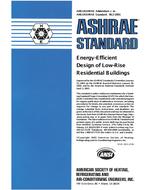Thermal sensation is affected by both the physical parameters of the environment and by individual variables such as activity and clothing. Much effort in comfort research has been given to the study of how different variables of the environment combine to produce comfort and satisfaction with the thermal environment. Fanger’s (1) well known comfort equation has a tptal of nine environmental variables; the equation has received experimental confirmation for only a few combinations of variables.
Less attention has been paid to the change of thermal sensation as we move away from the optimum point. Since all the physiological and environmental variables interact, the rate of change of sensation’ with air temperature is not constant but is a function of air speed, metabolic rate and other factors. Fanger extended his work to non-comfort conditiq,ns, both cold and warm, and produced a second equation which gives predicted mean vote (PMV), i.e., average thermal sensation of a group, as a function of the environmental variables. He assumes that thermal sensation is proportional to the thermal load on the body; the constant of proportionality varies with metabolic rate. The thermal load is defined as the difference between the internal heat production and the heat loss to the actual environment for a man hypothetically kept at the comfort values of the mean skin temperature and the sweat secretion at the actual activity level. In other words, it is the change in heat loss which would occur if a person were moved from a comfortable environment to the actual environment without any change in skin temperature or other physiological parameter.
Product Details
- Published:
- 1976
- Number of Pages:
- 15
- File Size:
- 1 file , 780 KB
- Product Code(s):
- D-SE-2416
- Note:
- This product is unavailable in Russia, Belarus


